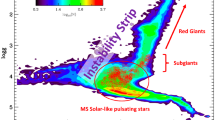Abstract
With more and more exoplanets being detected, it is paid closer attention to whether there are lives outside solar system. We try to obtain habitable zones and the probability distribution of terrestrial planets in habitable zones around host stars. Using Eggleton’s code, we calculate the evolution of stars with masses less than 4.00 M ⊙. We also use the fitting formulae of stellar luminosity and radius, the boundary flux of habitable zones, the distribution of semimajor axis and mass of planets and the initial mass function of stars. We obtain the luminosity and radius of stars with masses from 0.08 to 4.00 M ⊙, and calculate the habitable zones of host stars, affected by stellar effective temperature. We achieve the probability distribution of terrestrial planets in habitable zones around host stars. We also calculate that the number of terrestrial planets in habitable zones of host stars is 45.5 billion, and the number of terrestrial planets in habitable zones around K type stars is the most, in the Milky Way.
Similar content being viewed by others
References
Alexander, D.R., Ferguson, J.W.: Astrophys. J. 437, 879 (1994)
Bahcall, J.N., Pinsonneault, M.H., Wasserburg, G.J.: Rev. Mod. Phys. 67, 781 (1995)
Buccino, A.P., Lemarchand, G.A., Mauas, P.J.D.: Icarus 183, 491 (2006)
Carter, B., McCrea, W.H.: Phil. Trans. R. Soc. Lond. A 310, 347 (1983)
Chen, X.F., Tout, C.A.: Chin. J. Astron. Astrophys. 7(2), 245 (2007)
Clube, S.V.M., Hoyle, F., Napier, W.M., Wickramasinghe, N.C.: Astrophys. Space Sci. 245, 43 (1996)
David, E.-M., Quintana, E.V., Fatuzzo, M., Adams, F.C.: Publ. Astron. Soc. Pac. 115, 825 (2003)
Duquennoy, A., Mayor, M.: Astron. Astrophys. 248, 485 (1991)
Eggleton, P.P.: Mon. Not. R. Astron. Soc. 151, 351 (1971)
Eggleton, P.P.: Mon. Not. R. Astron. Soc. 156, 361 (1972)
Eggleton, P.P.: Mon. Not. R. Astron. Soc. 163, 279 (1973)
Eldridge, J.J., Tout, C.A.: Mon. Not. R. Astron. Soc. 348, 201 (2004)
Fatuzzo, M., Adams, F.C., Gauvin, R., Proszkow, E.M.: Publ. Astron. Soc. Pac. 118, 1510 (2006)
Ferguson, J.W., Alexander, D.R., Allard, F., et al.: Astrophys. J. 623, 585 (2005)
Forget, F., Pierrehumbert, R.T.: Science 278, 1273 (1997)
Franck, S., von Bloh, W., Bounama, C., et al.: J. Geophys. Res. 105, 1651 (2000)
Grevesse, N., Sauval, A.J.: Space Sci. Rev. 85, 161 (1998)
Grießmeier, J.-M., Stadelmann, A., Motschmann, U., et al.: Astrobiology 5(5), 587 (2005)
Guo, J.P., Zhang, F.H., Chen, X.F., Han, Z.W.: Chin. J. Astron. Astrophys. 8(3), 262 (2008)
Han, Z.W., Podsiadlowski, Ph., Eggleton, P.P.: Mon. Not. R. Astron. Soc. 270, 121 (1994)
Hart, M.H.: Icarus 33, 23 (1978)
Hurley, J.R., Pols, O.R., Tout, C.A.: Mon. Not. R. Astron. Soc. 315, 543 (2000)
Ida, S., Lin, D.N.C.: Astrophys. J. 604, 388 (2004)
Ida, S., Lin, D.N.C.: Astrophys. J. 626, 1045 (2005)
Ida, S., Lin, D.N.C.: Astrophys. J. 673, 487 (2008)
Iglesias, C.A., Rogers, F.J.: Astrophys. J. 464, 943 (1996)
Jones, B.W.: Life in the Solar System and Beyond. Springer, Berlin (2004)
Jones, B.W., Sleep, P.N., Underwood, D.R.: Astrophys. J. 649, 1010 (2006)
Kasting, J.F., Whitmire, D.P., Reynolds, R.T.: Icarus 101, 108 (1993)
Kroupa, P., Tout, C.A., Gilmore, G.: Mon. Not. R. Astron. Soc. 262, 545 (1993)
Lal, A.K.: Astrophys. Space Sci. 317, 267 (2008)
Marois, C., Macintosh, B., Barman, T., et al.: Science 322, 1348 (2008)
Menou, K., Tabachnik, S.: Astrophys. J. 583, 473 (2003)
Mischna, M.A., Kasting, J.F., Pavlov, A., Freedman, R.: Icarus 145, 546 (2000)
Mojzsis, S.J., Harrison, T.M., Pidgen, R.T.: Nature 409, 178 (2001)
Noble, M., Musielak, Z.E., Cuntz, M.: Astrophys. J. 572, 1024 (2002)
Pols, O.R., Tout, C.A., Eggleton, P.P., Han, Z.W.: Mon. Not. R. Astron. Soc. 274, 964 (1995)
Pols, O.R., Tout, C.A., Schröder, K.-P., et al.: Mon. Not. R. Astron. Soc. 289, 869 (1997)
Pols, O.R., Schröder, K.-P., Hurley, J.R., et al.: Mon. Not. R. Astron. Soc. 298, 525 (1998)
Richichi, A., Leinert, Ch., Jameson, R., Zinnecker, H.: Astron. Astrophys. 287, 145 (1994)
Rosing, M.T.: Science 283, 674 (1999)
Saleh, L.A., Rasio, F.A.: Astrophys. J. 694, 1566 (2009)
Schlaufman, K.C., Lin, D.N.C., Ida, S.: Astrophys. J. 691, 1322 (2009)
Schröder, K.-P., Pols, O.R., Eggleton, P.P.: Mon. Not. R. Astron. Soc. 285, 696 (1997)
Tarter, J.C., Backus, P.R., Mancinelli, R.L., et al.: Astrobiology 7(1), 30 (2007)
Tout, C.A., Pols, O.R., Eggleton, P.P., Han, Z.W.: Mon. Not. R. Astron. Soc. 281, 257 (1996)
Valencia, D., O’Connell, R.J., Sasselov, D.: Icarus 181, 545 (2006)
von Bloh, W., Bounama, C., Cuntz, M., Franck, S.: Astron. Astrophys. 476, 1365 (2007)
Watson, A.J.: Astrobiology 8, 1 (2008) 175
Weiss, A., Salaris, M., Ferguson, J.W., Alexander, D.R.: Preprint (2006). astro-ph/0605666
Williams, D.M., Kasting, J.F.: Icarus 129, 254 (1997)
Williams, D.M., Kasting, J.F., Wade, R.A.: Nature 385, 234 (1997)
Author information
Authors and Affiliations
Corresponding author
Rights and permissions
About this article
Cite this article
Guo, J., Zhang, F., Chen, X. et al. Probability distribution of terrestrial planets in habitable zones around host stars. Astrophys Space Sci 323, 367–373 (2009). https://doi.org/10.1007/s10509-009-0081-z
Received:
Accepted:
Published:
Issue Date:
DOI: https://doi.org/10.1007/s10509-009-0081-z




